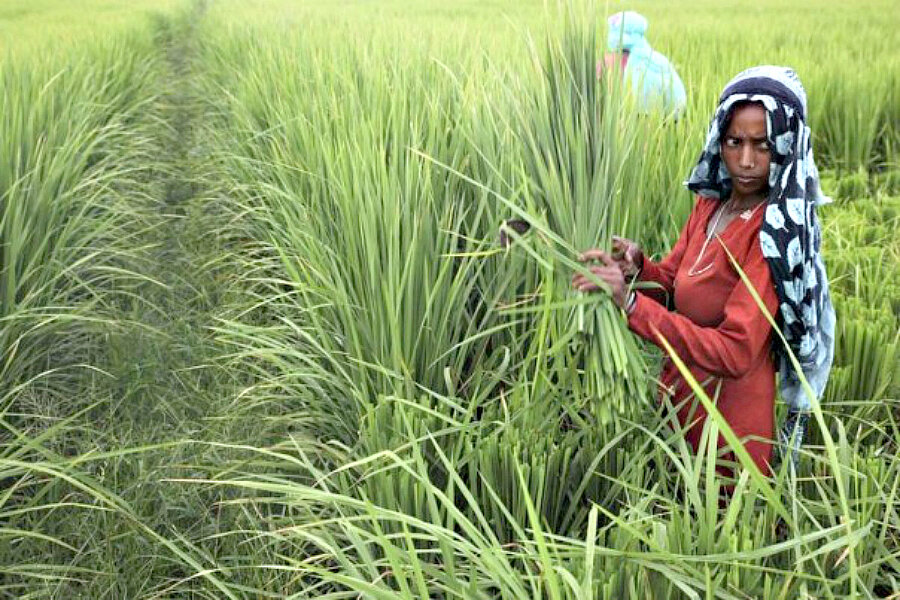Climate-smart farmers get tech savvy to save India's breadbasket
Loading...
| Karnal, India
Erratic weather, rising temperatures, declining water resources, and labor shortages are threatening India's breadbasket state of Haryana, forcing farmers to abandon age-old practices and adopt technology to ensure food supplies for millions.
Using machines which sow rice directly, devices to inform when to irrigate, and phone messages warning of infestations, thousands of farmers are learning to adapt to climate change, boost soil fertility, and reduce their carbon emissions.
"At first, many farmers were unsure. It's a big risk to change the way you have farmed for decades and try new things. Agriculture in these parts is not just a livelihood, it's a way of life," said Harpreet Singh, 36, a farmer in the village of Birnaraya, 130 km (80 miles) north of Delhi.
"But over the last four years, through these technologies, we have learned to save water and fertilizers, cut our costs for hired labor, improved the resilience of our crops, and also reduced pollution by not burning crop residues."
Singh is from one of 12,000 farming households across 27 villages in Haryana's Karnal district working with scientists from the Consultative Group on International Agricultural Research (CGIAR) to pilot climate smart techniques aimed at sustaining one of the country's most fertile belts.
Since India's so-called "Green Revolution" – a massive government program rolled out in the 1960s and 1970s which increased the use of fertilizers and irrigation to boost farm output – Haryana's rice production has soared to almost 4 million tons in 2013/14, compared with 334,000 tons in 1966/67.
But while the Green Revolution may be credited with ending famine across the country, it has come at a cost and, coupled with more unpredictable weather attributed to global warming, India's food security is once again at risk.
Almost half a century on, farmers face environmental problems such as depleted groundwater because of intensive pumping for irrigation, soil degradation, and soil salinity.
"Resources are depleting. Groundwater levels are falling, there is emerging climate variability, the soil health is worsening, and profitability is going down," said M.L. Jat, an agronomist with the International Maize and Wheat Improvement Center.
The Indo-Gangetic Plains – which include the rice and wheat states of Haryana and Punjab – are particularly vulnerable to climate change, say experts from the U.N. Intergovernmental Panel on Climate Change (IPCC).
Scientists predict average temperatures here to increase by as much as 5 degrees Celsius (9 degrees F.) by 2080, seriously affecting wheat crops. An April study by the Indian Agricultural Research Institute projects climate change may reduce India's wheat yield by between 6 to 23 percent by 2050.
Rice will also be hit due to unpredictable rainfall. Indian officials say the water table has fallen between one and 13 meters in different parts of Karnal over the last two decades.
The region, which is heavily dependent on migrant labor from poorer states, is also facing shortages due to a government scheme to employ more people in construction near their homes.
In response to these challenges, agricultural groups are introducing Karnal's farmers to a host of climate smart technologies.
These include techniques such as direct seeding, which involves sowing seeds by machines rather than transplanting manually, which reduces labor and water.
Other new technology includes Lazer Levellers – tractor-towed, laser-controlled devices – that produce a flat surface for cultivation, requiring 25 to 30 percent less water.
Farmers are being introduced to tools such as "Happy Seeders," which can be attached to the back of tractors. These remove crop residues, blending them into the soil, preventing the practice of burning crop residues that has led to increased emissions and depleted soil fertility.
"We didn't know anything about these advanced-technology machines before," said Manoj Kumar Munjal, 40, who farms a 20-acre plot of land in Taorori village.
"We have learned about these machines and set up a cooperative where we all put in the money together and bought machines and share them. Now everyone is using it."
Farmers are also receive voice messages giving weather forecasts, informing of new seed varieties and infestations.
But these technologies do not come cheap. A Lazer Leveller, for example, costs more than $6,000.
In villages such as Munjal's, farmers have clubbed together to buy new machinery, while in others, one farmer invests in the hardware and rents it out to others.
CGIAR said a similar project is underway in the eastern state of Bihar using lower-cost techniques on smaller plots.
On his sprawling 90-acre farm, Harpreet Singh crouched down among his rice paddy stalks and checked his tensiometer, a device planted in the ground to measure moisture content.
Singh said over the last four years, his income has increased by 15 percent due to savings made on electricity for irrigation, diesel for residue burning, labor and fertilizers. But it is the saving on water which satisfies him the most.
"Day by day, the ground water levels are going down and down. If we continue like this, its only a matter of time before we don't have water to drink, let alone to farm," he said.
(Editing by Ros Russell: rosalind.russell@thomsonreuters.com)
• This article originally appeared at Thomson Reuters Foundation, a source of news, information, and connections for action. It provides programs that trigger change, empower people, and offer concrete solutions.





